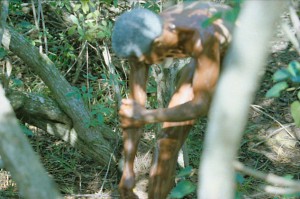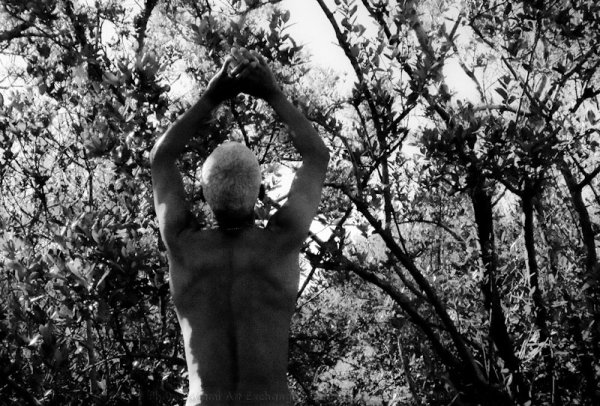 The culmination of 10 months of work I had been working outdoors doing ephemeral works and expanded my performative – action works to create a work that brought the outdoors indoors. There was a sound loop of running water from a stream (similar to the one nearby the campus) and the sounds of water fowl to create a haunting, but richly nuanced environment that echoed nature.
The culmination of 10 months of work I had been working outdoors doing ephemeral works and expanded my performative – action works to create a work that brought the outdoors indoors. There was a sound loop of running water from a stream (similar to the one nearby the campus) and the sounds of water fowl to create a haunting, but richly nuanced environment that echoed nature.
Using the altar as a vehicle for historical reconstruction, and the destruction and disruption caused by the slave trade and the imposition of Christianity and foreign culture, African people and their descendants in the Americas maintained the essential elements of African religious traditions through improvisations and adaptations to local context. This hidden aspect of African cultural life weaves its way into many parts of artistic expression.
“Of all human proclivities, few are more intriguing than the contradictory tendencies at once to create, guard, and maintain a secret and to be the source of its revelation,” states Suzanne Preston Blier.(1) The secret or hidden meaning of things puts a barrier between people and understanding and at the same time creates the tempting challenge to break through it or just totally ignore it. According to Deleuze and Guattari, “The secret [does]… not contain itself with concealing its form in a simple container… The secret, as secret, must now acquire its own form.”(2)
Secrecy is about power and control. Art that contains secrets do so according to a visual grammar. Some of the strategies that permit them to suggest the presence of the secret and to camouflage it are: coding, obscurity, accumulation, containment and, ambiguity.(3) The ability to obscure is a communication skill and is considered a valuable tool under the proper circumstances. I have used several of these strategies in my work but have recently felt that a different approach was needed because of a general lack in understanding Black Atlantic cultures. I saw a gap that needed to be closed and therefore have fully placed my work within the African diasporaic framework. This context has determined the works meaning and its interpretation.
My aim has been to set up a new understanding of postcolonial artistic practice that is coming into being through complex effects of institutions, histories, human experiences and natures. Nature is used as a metaphor for deciphering the multivalent relationships of the history of artistic and political practice. Radical change demands new formal understandings and its appreciation in diasporic history. The potential for ethnobotany to provide other forms of classification and that natural orders can be interpretated differently is in the institution of new forms or new ways in which people relate themselves to this artwork of my creation.

“Mangrove Prayer #2”
archival pigment print
12 x 19 in. / 30.5 x 48.25 cm
Three primary goals in mind: 1) to familiarize the viewer with African Atlantic art, culture and its aesthetic groundings; 2) to examine the transformation of these cultural forms in the U.S. American context into uniquely and innovatively African American expressions; and 3) to unseat traditional notions of the art object being made solely of precious materials but being of poor materials and having the ability to contain “deep” meaning.
From the mid-nineteenth century, the major European powers started a scramble for territory so much so that by 1914, more than 3/4ths of the world was controlled by Europeans. Therefore, African American vernacular English is an important postcolonial construct that is persistent within the parameters of history, identity and pedagogy.
My particular use of U.S. Southern vernacular clearly brings about a certain tension because education researchers have used the science of language to denigrate African Americans and their mental competence by equating language performance with language ability, and language ability with cognitive ability.
Zora Neale Hurston also invokes African derived images such as the sacred tree. The tree, as Hurston would have known, is a central Voudou symbol and often signifies the sexual and spiritual union of the primary male and female deities. The sacred tree, then, as an image of spiritual and sexual ecstasy, counters the Judeo-Christian images of the tree-of-knowledge and the crucifix-tree that represent the dangers of bodily knowledge and the painful renunciation of physical existence. This tree-and-serpent emblem symbolizes a spiritual healing of the damaging divisions of the body and soul, sex and spirit, male and female, animal and divine.
*1) Blier, Suzanne Preston, “Art and Agency: Concealment and Revealation in Artistic Expression,” in Secrecy: African Art that Conceals and Reveals, edited: Nooter, Mary H., (New York, Munich, Prestel, The Museum for African Art, 1993), pp181-194
*2) Deleuze, Gilles, & Felix Guattari. A Thousand Plateaus: Capitalism and Schizophrenia. Trans. and Foreword by Brian Massumi (Minneapolis: U of Minnesota, 1987) pg 288
